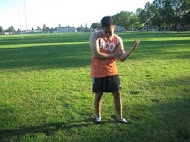Rotator cuff tendinitis is a condition that affects the tendons and muscles that function in helping with the movement of the shoulder joint. Tendinitis is the inflammation and irritations of the tendons. Rotator cuff tendinitis is also known as impingement syndrome.
Rotator cuff tendinitis usually happens over time which can be caused by keeping the shoulder in one position for long periods of times, performing activities that requires extending of the arm over the head and sleeping on the shoulder every night. Rotator cuff tendinitis can also be called pitcher’s shoulder, tennis shoulder and swimmer’s shoulder.
Common symptoms
- Pain that causes interruption while sleeping
- Pain that spreads behind the back
- Stiffness of the affected area
- Losing mobility and strength in the affected arm
- Pain that can be felt in the front of the shoulder and at the side of the arm
- Pain when raising or lowering the arm
- A clicking sound can be heard when raising the arm

Treatment
- Take the prescribed pain medication such as ibuprofen or naproxen to help in minimizing the pain and swelling.
- Apply an ice pack to the affected shoulder at least 20 minutes at a time for 3-4 times every day to help in minimizing the pain. Another way is by encouraging the individual to a hot bath or shower to helps lessen the pain felt in the shoulder.
- When sleeping, lie on either side of the back that does not cause pain. Rest the shoulder that causes pain in a couple of pillows to minimize the pain.
- When sitting, maintain a good posture, keep the head over the shoulder and place a pillow or towel behind the lower back and keep the feet up on a foot stool or flat on the floor.
- Avoid carrying a backpack or purse on one shoulder
- Gradually return to sports and other activities and seek the help of a physical therapist regarding the proper techniques that should be done when performing activities that involves movement of the shoulders.
- Begin performing mild exercises to help gradually restore full movement of shoulder back to normal.
- The therapist will help with the exercises that focus on strengthening the muscles of the shoulder.
Tips and prevention
- When reaching using the arm, the thumb should be pointing up.
- Avoid working using the arm above the level of the shoulder for long periods of time. Always use a foot stool or ladder.
- Take a break from any activities that are performed over and over again.
- Keep items that are used every day in places that can be reached easily.
- Keep things that are frequently used such as the phone near or close to the person in order to avoid reaching and re-injuring the affected shoulder.
- Lift and carry things close to the body and avoid lifting heavy loads overhead.
